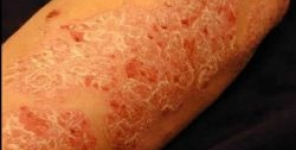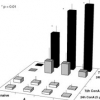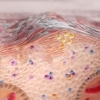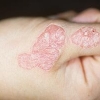Melanoma cutaneo nei pazienti trattati con inibitori del fattore di necrosi tumorale: un'analisi retrospettiva di 15 pazienti
 Diversi case report suggeriscono che gli inibitori del fattore di necrosi tumorale-α (TNF) potrebbero aumentare l'incidenza del melanoma e/o alterarne il corso naturale verso un comportamento più aggressivo.
Diversi case report suggeriscono che gli inibitori del fattore di necrosi tumorale-α (TNF) potrebbero aumentare l'incidenza del melanoma e/o alterarne il corso naturale verso un comportamento più aggressivo.
Obiettivo
Il nostro obiettivo è stato quello di verificare se, nei pazienti esposti agli inibitori del TNF, la storia clinica del melanoma si potesse presentare con un particolare modello alla diagnosi o durante il follow-up.
Metodi
Abbiamo condotto uno studio multicentrico retrospettivo nella parte occidentale della Francia per raccogliere ed analizzare tutti i casi di pazienti con melanoma che avevano ricevuto la terapia a base di anti-TNF.
Risultati
In totale sono stati considerati quindici casi. Un primo gruppo di 10 pazienti (con età media: 55.6 anni; rapporto tra i sessi 1:1) che hanno ricevuto la diagnosi di melanoma dopo l'inizio della terapia a base di inibitori del TNF; la durata media tra l'inizio del trattamento e la scoperta del melanoma è stata di 48.7 mesi; due di questi pazienti sono morti a causa della malattia metastatica. Un secondo gruppo di quattro pazienti che avevano avuto una storia di melanoma prima della terapia con anti-TNF (durata media del trattamento: 10.8 mesi); nessuno di questi ha avuto una progressione del melanoma. Infine, una donna che aveva avuto una storia di melanoma prima del trattamento e che poi ha sviluppato un secondo melanoma quando è stata esposta alla bioterapia.
Conclusione
La nostra serie di casi non rivela un profilo distinto del melanoma nei pazienti esposti agli inibitori del TNF. Sono comunque necessari ulteriori studi prospettici, che includano un maggior numero di pazienti, in modo da dimostrate il possibile legame tra la terapia biologica con inibitori del TNF e lo sviluppo del melanoma.
Storia della pubblicazione:
Titolo: Cutaneous melanoma in patients treated with tumour necrosis factor inhibitors: a retrospective series of 15 patients
Rivista: Journal of the European Academy of Dermatology and Venereology. doi: 10.1111/jdv.12347
Autori: C. Chabbert, H. Adamski, G. Guillet, B. Sassolas, L. Misery, A. Perrinaud, L. Machet, G. Quereux, E. Esteve, E. Solau-Gervais, A. Saraux, E. Polard, T. Lesimple, F. Le Gall, B. Dreno, A. Dupuy
Affiliazioni:Department of Dermatology, University Hospital of Rennes, Rennes, France Department of Dermatology, University Hospital of Poitiers, Poitiers, France Department of Internal Medicine and Pneumology, University Hospital of Brest, Brest, France Department of Dermatology, University Hospital of Brest, Brest, France Department of Dermatology, University Hospital of Tours, Tours, France Department of Dermatology, University Hospital of Nantes, Nantes, France Porte-Madeleine Hospital of Orléans, Cedex, France Department of Rheumatology, University Hospital of Poitiers, Poitiers, France Department of Rheumatology, University Hospital of Brest, Brest, France Pharmacovigilance Center, University Hospital of Rennes, Rennes, France Oncology Center (Centre Régional de Lutte contre le Cancer) of Rennes, Rennes, France Department of Pathology, University Hospital of Rennes, Rennes, France
Abstract:
Background Several case reports suggested that tumour necrosis factor-α (TNF) inhibitors might increase the incidence and/or alter the natural course of melanoma towards a more aggressive behaviour. Objective Our objective was to point if history of melanoma in patients exposed to TNF inhibitors could present with a particular pattern at diagnosis or during follow-up. Methods We performed a retrospective multicentre study settled in the West part of France to collect and analyse all cases of patients with melanoma who received anti-TNF therapy. Results Fifteen cases were included. First, 10 patients (mean age: 55.6 years; sex ratio: 1) had a melanoma diagnosed after TNF inhibitors initiation. The mean duration between initiation of treatment and melanoma was 48.7 months. Two patients died of metastatic disease. Second, four patients had a past history of melanoma before anti-TNF therapy (mean duration of treatment: 10.8 months). None experienced a progression of melanoma disease. Last, one woman had a past history of melanoma before and then developed a second melanoma when exposed to biotherapy. Conclusion Our case series does not reveal a distinct profile of melanoma in the patients exposed to TNF inhibitors. Additional prospective trials including larger number of patient are needed to demonstrate the possible link between biological therapy with TNF inhibitors and development of melanoma.





